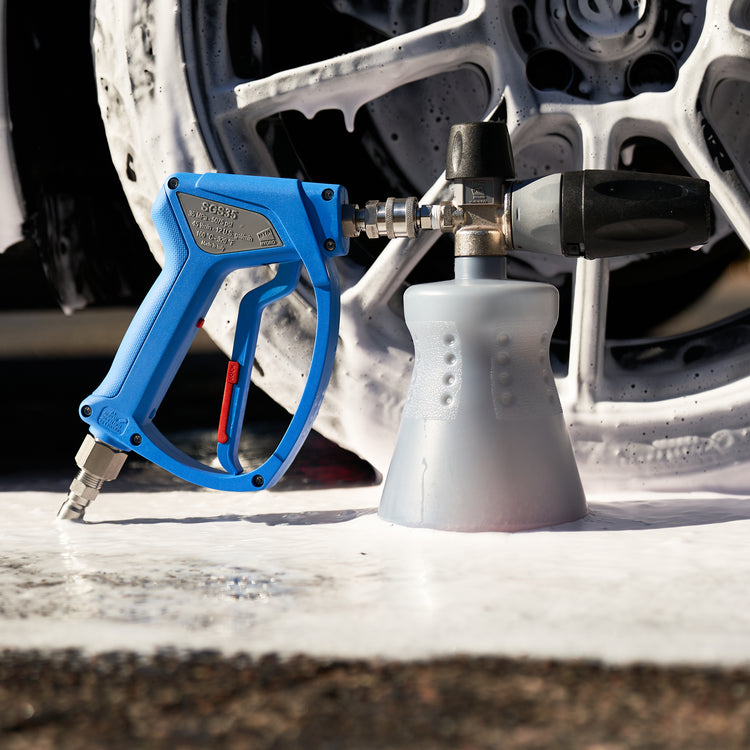Foam Cannon Orifices: An In-Depth Guide
1. Introduction to Foam Cannons
Foam cannons are devices used with pressure washers to spray a thick layer of foam, typically for car washing or other cleaning applications. The foam helps to loosen and remove dirt and grime effectively. The orifice within the foam cannon is a crucial component that affects the performance of the foam cannon by regulating the pressure and flow rate of the water/soap mixture.
2. Understanding Orifices
- Definition: An orifice in a foam cannon is a small, precisely-sized hole or nozzle that controls the water flow rate and pressure as it exits the pressure washer and mixes with the soap.
- Function: The orifice determines the density and coverage of the foam by influencing the water pressure and flow rate.
3. Orifice Sizes and Their Impact
- Measurement: Orifices are measured in millimeters (mm) or assigned a number that correlates to their size (e.g., 1.1, 1.25, 1.35, 3.0, 3.5, etc.).
-
Size Range: Common orifice sizes range from 1.1 mm to 5.0 mm.
- Smaller Orifices (e.g., 1.1 mm): Restrict water flow, resulting in higher pressure and potentially thicker foam.
- Larger Orifices (e.g., 5.0 mm): Allow more water flow, resulting in lower pressure and possibly less dense foam.
4. Matching Orifices with Pressure Washers
- Pressure (PSI): Pounds per square inch, indicating the pressure exerted by the water.
- Flow Rate (GPM): Gallons per minute, indicating the volume of water flowing through the pressure washer.
- Ideal Pairing: The orifice size must match the pressure washer’s PSI and GPM to optimize foam production.
5. Choosing the Right Orifice Size
-
Formula: Orifice size is often chosen based on a balance between PSI and GPM.
- Example: A pressure washer with 2000 PSI and 3.5 GPM typically requires a 5.0 orifice.
-
General Guidelines:
- High PSI + Low GPM = Smaller orifice.
- Low PSI + High GPM = Larger orifice.
6. Common Orifice Sizes and Their Uses
- 1.1 mm Orifice: Suitable for small electric pressure washers (e.g., 1600 PSI, 1.2 GPM).
- 1.25 mm Orifice: Commonly used for medium electric pressure washers (e.g., 2000 PSI, 1.4-1.6 GPM).
- 1.35 mm Orifice: Typically used for larger electric or smaller gas pressure washers (e.g., 2300 PSI, 2.0 GPM).
- 3.0 to 5.0 Orifice: Used for higher flow, lower pressure machines (e.g., 2000 PSI, 3.5 GPM).
7. Installation and Maintenance
- Installation: Orifices are typically threaded and can be unscrewed and replaced with a different size using appropriate tools.
-
Maintenance:
- Cleaning: Regularly clean the orifice to prevent clogging from dirt or soap residue.
- Inspection: Check for wear and tear, especially if the foam cannon is used frequently.
8. Troubleshooting Common Issues
- Inconsistent Foam: May be due to an incorrectly sized orifice or clogs.
- Poor Foam Quality: Often caused by a mismatch between the orifice size and the pressure washer’s PSI and GPM.
- Leaks or Damage: Ensure proper installation and check for any damage to the orifice or foam cannon components.
9. Advanced Tips
- Experimentation: Adjusting orifice size can help fine-tune foam density and coverage for specific applications.
- Backup Orifices: Keep a range of orifice sizes on hand to quickly adapt to different pressure washers or cleaning tasks.
- Quality and Materials: Invest in high-quality orifices made from durable materials like stainless steel to ensure longevity and performance.
10. Conclusion
Becoming an expert in foam cannon orifices involves understanding the relationship between orifice size, PSI, and GPM, knowing how to choose the right orifice for your pressure washer, and maintaining your equipment to ensure optimal performance. By mastering these details, you can achieve the perfect foam consistency for any cleaning task.
11. Glossary
- PSI (Pounds per Square Inch): A unit of pressure.
- GPM (Gallons per Minute): A unit of flow rate.
- Orifice: A precisely-sized hole that regulates the flow and pressure of water in a foam cannon.
12. References and Further Reading
- Manufacturer manuals for specific pressure washers and foam cannons.
- Online forums and communities dedicated to car detailing and pressure washing.
- Technical guides and resources from pressure washer and foam cannon manufacturers.
